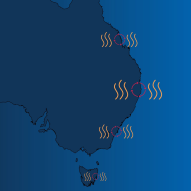
Is there a link between heatwaves on land and heatwaves in the ocean?
May 24, 2023 2:42 pm Comments Off on Is there a link between heatwaves on land and heatwaves in the ocean?Heatwaves in the ocean are having major impacts on heatwaves on land.

Heatwaves in the ocean are having major impacts on heatwaves on land.

The Southern Ocean is the most turbulent part of the world’s oceans. This turbulence, often referred to as eddies, is critical to the evolution of the Southern Ocean under climate change. But it’s hard to get information about these eddies, because they occur on small scales in a large ocean basin that is poorly observed. In addition, the observational record is quite short, which makes it more difficult to use these observations to study what controls variations of these eddies.... View Article

In a world first, Centre postdoctoral researcher Dr Mat Lipson and colleagues partnered with Australian companies AURIN and Geoscape to transform the way cities can be integrated in weather and climate models. The research was enabled by a new generation of sub-metre urban morphology data sets covering entire continents and powered by machine learning, satellite imagery and remote sensing. From these new data sets they could, for the first time, configure our urban climate models across large geographical extents with... View Article

Phytoplankton, microscopic marine algae that photosynthesize, facilitate the sequestration of carbon dioxide from the atmosphere into the ocean, thus contributing to the regulation of global climate. In the Southern Ocean, phytoplankton productivity is limited by micronutrients, including iron. Light is also important, because it undergoes such strong seasonal extremes. The relative dominance of iron and light limitation on phytoplankton growth is important to our understanding of how primary production, and the sequestration of carbon dioxide, will change in a future... View Article

Annual net community production is the amount of biologically produced carbon available for export to the deep ocean. Ocean Extremes program researchers developed a novel approach to estimate annual net community production in the Southern Ocean, using robotic biogeochemical Argo (BGC-Argo) floats. Using our improved method, we calculated total Southern Ocean annual net community production to be 3.89 billion tonnes of carbon per year. This estimate is much larger than previous estimates, which suggests a more important role than previously... View Article

Australia’s rainfall is highly variable, and long-term (100-plus years) observational records from rain gauges are limited, making it difficult to develop robust water policies and infrastructure that mitigates and adapts to future rainfall extremes. Relying solely on the severity of droughts and floods experienced since observations and meteorological record-keeping began in Australia for water-resource management decisions leaves communities, agriculture and industry vulnerable to infrastructure failure when the magnitude of future droughts or floods exceed previously experienced extremes. In her 2022... View Article

The Southern Annular Mode is a major mode of climate variability that influences climate extremes across the Southern Hemisphere, including drought in southern Australia. Proxy-based Southern Annular Mode reconstructions show large changes during the last millennium that current climate simulations don’t reproduce. Research led by Dr Nicky Wright tested the Southern Annular Mode’s sensitivity to solar forcing by using simulations with a range of constant solar values and transient last-millennium simulations with large-amplitude solar variations. The work found that solar... View Article

Atmospheric rivers are narrow regions of strong moisture transport in the lower atmosphere. They can cause beneficial rainfall – on average, atmospheric rivers contribute 20 to 35 percent of south-east Australia’s and 10 to 20 percent of south-west Australia’s annual rainfall. However, they can also be disastrous, with 20 to 30 percent of the heaviest rainfall days in the northern Murray-Darling Basin occurring during atmospheric rivers – including the devastating February-March floods in 2022. That year, Dr Kim Reid and... View Article

Time of emergence is a concept showing when the trend in a climate variable emerges above the “noise” of natural climate variability. A study led by Centre of Excellence PhD student Xu (Pete) Deng used large ensembles of the latest state-of-the-art climate models and a range of future scenarios to understand this concept for temperature extremes over Australia. The strongest warming levels, and therefore earlier time of emergence, are projected under the highest future scenario, with tropical Australia usually showing... View Article

A critical question in hydrology is the extent to which climate change is affecting changes in rainfall, evapotranspiration and runoff over land and how this might impact human activity. We demonstrate that more than 50 percent of the land surface has experienced robust changes in these hydrological cycle components since 1980. Of particular concern is increasing water-resource stresses in key breadbasket regions, including in Australia, and in some densely populated areas. Using a diverse range of observations, in combination with... View Article